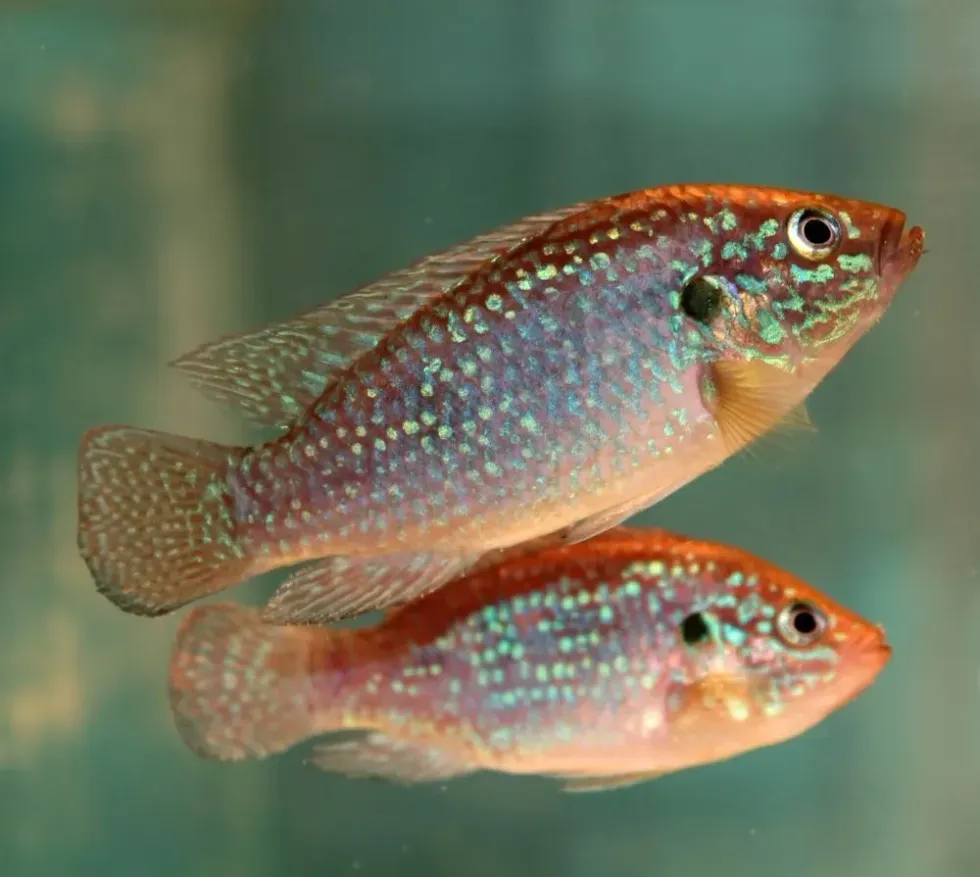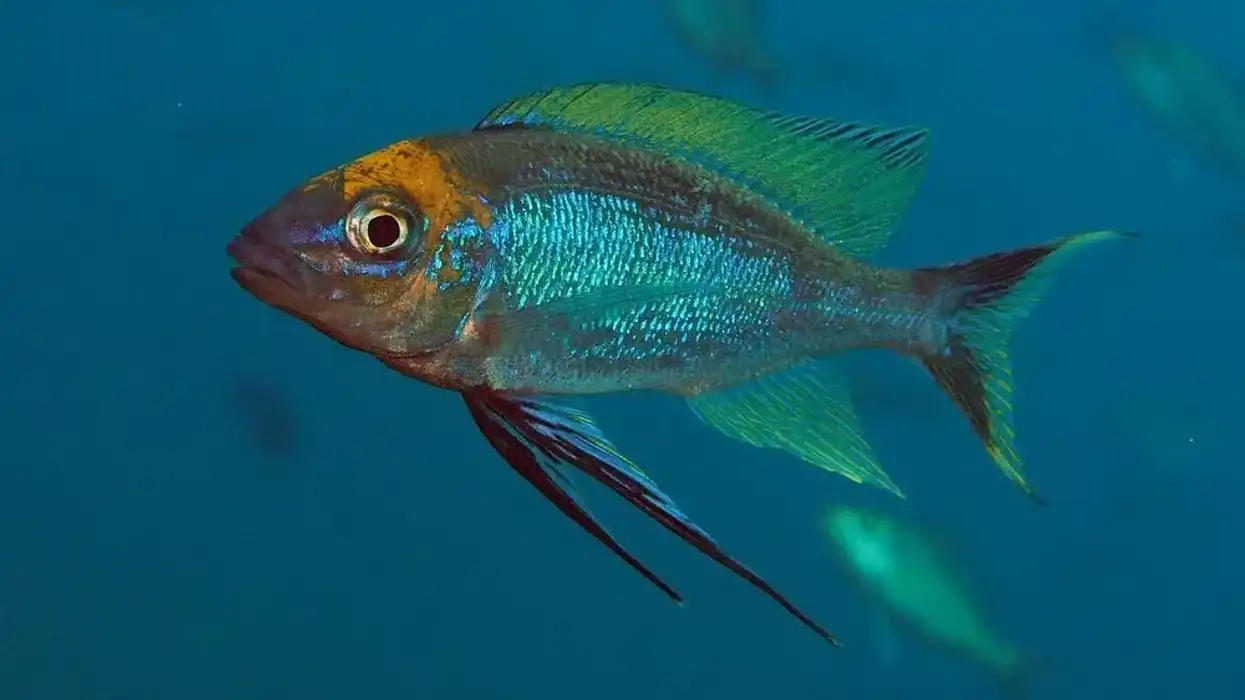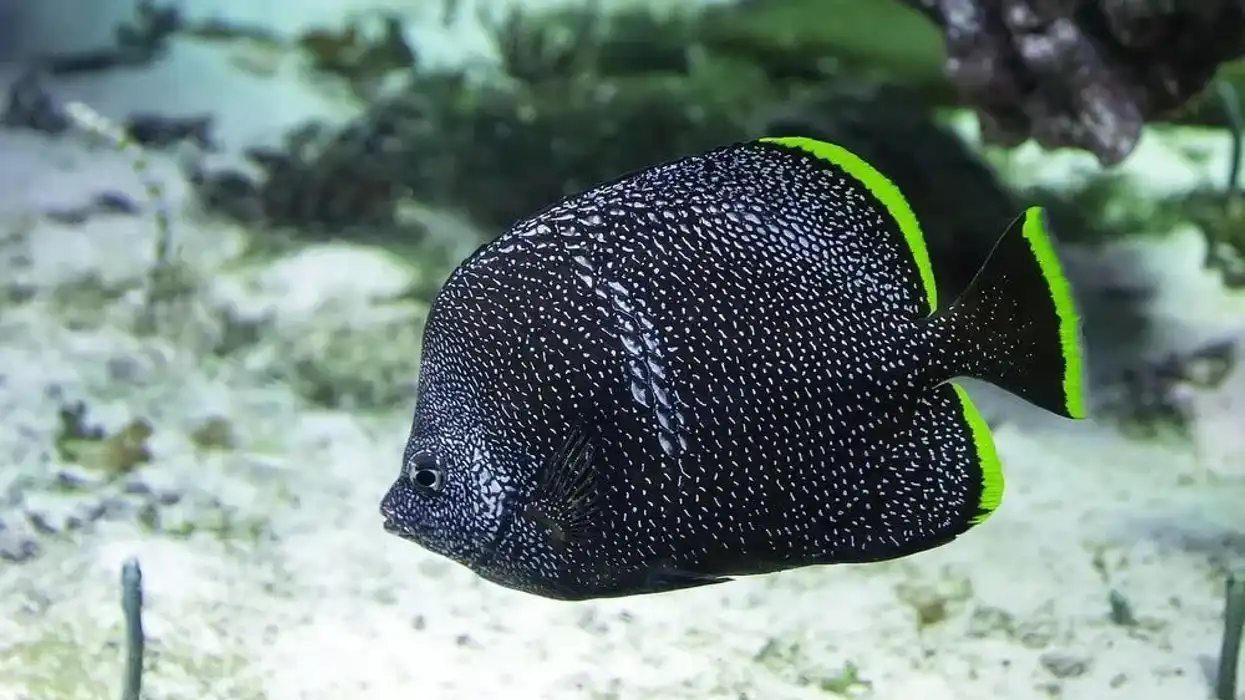The Merriam-Webster dictionary defines the jewelfish as a small fish that is scarlet and olive in color with specks of emerald or sapphire, has African origins, and is sometimes kept in a tropical aquarium. The fish is believed to have been introduced in Florida, as a nonindigenous aquatic species for the first time in an aquarium.
Superficially, cichlids are similar to sunfishes and black basses.
Cichlids are different from centrarchids. The difference lies in the physical features. It is a freshwater fish.
However, it may also reside in brackish waters. This freshwater fish can adjust well to changes in the salinity of the surrounding water.
Also, it is tolerant of hypoxia. The African jewelfish, Hemichromis letourneuxi, is a native of West Africa. It is a non-native cichlid that is found in the South of Florida.
Like reading about the African jewelfish, Hemichromis letourneuxi? Want to know more about the life of this fish species? Let's move on.
If you like reading this article, you may also like reading about bonito fish and rainbow trout.
Jewelfish Interesting Facts
What type of animal is a jewelfish?
The jewelfish is a fish belonging to the phylum Chordata, order Cichliformes, and family Cichlidae.
What class of animal does a jewelfish belong to?
The jewelfish belongs to the class Actinopterygii.
How many jewelfishes are there in the world?
According to the International Union for Conservation of Nature (IUCN) Red List of Threatened Species, the population trend of these fishes of the family Cichlidae is unknown. Also, according to the International Union for Conservation of Nature (IUCN), Red List of Threatened Species, the population of this fish of the family Cichlidae is not severely fragmented.
Where does a jewelfish live?
The jewelfish is found in over a wide range in tropical Africa. It is found in West Africa, Central Africa, and the Nile Basin. They were introduced in Florida as a nonindigenous aquatic species. The Florida African jewelfish, Hemichromis letourneuxi is found in the Everglades as well.
What is a jewelfish's habitat?
The jewelfish live in rivers, canals, wetlands, drainage ditches, shallow ponds, and streams. It is especially found in forested regions where the trees overhang on the surface of the water bodies. These water fishes are mostly associated with aquatic plants and submerged terrestrial plants.
Who do jewelfishes live with?
African jewelfish are seen in pairs in the breeding season. The cichlid jewelfish may also be seen with their offspring.
How long does a jewelfish live?
The African jewelfish can have a lifespan of more than five years in captivity.
How do they reproduce?
The females turn bright red in color to let the male know that they are ready to mate. Breeding starts when the males and the females of the species bond and then the males release their sperm on the eggs (around 600) in order to fertilize them.
The females are extremely protective of their eggs that are kept on a flat surface.
They are ready to kill as well. The females guard their offspring after breeding as well. Research states that these fish can reproduce every three weeks.
What is their conservation status?
According to the International Union for Conservation of Nature (IUCN) Red List of Threatened Species, the status of African jewelfish is Least Concern.
Jewelfish Fun Facts
What do jewelfishes look like?

Jewelfish are bright in color. The color of the fish intensifies during the breeding season. The freshwater fish is cherry red in color with light blue jewel spots all over the body. Two large eyespots that are black in color are located along the lateral line.
There is a black spot behind the gill. Another black spot is located in the middle of the body. There are three spines on the anal fin. The caudal fin has a dense scaled base and is rounded.
How cute are they?
The fish are very cute to look at with the reflective light blue spots shimmering all over their bodies.
How do they communicate?
Research suggests that jewel cichlids communicate using sounds. The sounds produced by the male African jewelfish and the female fish African jewelfish are different. It is usually associated with aggressive behavior. Thump sounds made by the fishes are associated with a behavior called nodding.
Nodding represents a high level of aggressive behavior. Purring is associated with lateral display and tail beating. This behavior is synonymous with the beginning of courtship or attack. Low-frequency pulses emitted in series are associated with courtship quivering.
How big is a jewelfish?
The jewelfish reaches up to 6 in (15 cm) in length. The Hemichromis bimaculatus is smaller than the Hemichromis fasciatus. The jewelfish is smaller than the tang fish and salmon.
How fast can a jewelfish swim?
The information is not available for the species.
How much does a jewelfish weigh?
This information is not available for the species.
What are the male and female names of the species?
The male and the female of the species do not have sex-specific names.
What would you call a baby jewelfish?
A baby neon jewelfish is called a fry. Within two or three years, the fish grows to its full size.
What do they eat?
The Hemichromis bimaculatus is an omnivore. The African jewelfish preys upon a range of creatures including the crustaceans, insects, Caridina (shrimps and prawns), and shrimp pellets. It may also feed on aquatic green vegetation found in the rivers and canals.
In captivity, the diet of the African jewelfish usually comprises brine shrimps, Spirulina, Omnivore Pellet, and Blackworms. Feeding fresh food is recommended. Quality of food should be given priority over quantity.
Are they dangerous?
The Hemichromis bimaculatus can attack and bite human fingers.
Would they make a good pet?
The jewelfish blue of the cichlid family is pretty aggressive and needs to be handled cautiously. The jewelfish blue of the cichlid family should be kept away from most other species of fish in an aquarium. The pH of the water needs to be prior maintained at 7.2-8.0.
Clearly, the water should be slightly basic. Also, hard water (12-18 dGH) should be used. The temperature should be prior maintained at 70-80 ° F (21.1-26.6 ° C).
They may be kept in the same enclosure with Synodontis and other African Cichlids. It is important to keep the water fresh.
In captivity, isolated breeding is recommended for the species. These fishes are not suitable for community aquariums owing to their aggressive behavior. These fishes like to eat the algae at the bottom of a fish tank.
They are also known to practice filial cannibalism, that is, they prey on their young ones. Fascinating, eh? !
Did you know...
The genus Hemichromis has 13 recognized species under it.
The study surrounding jewelfish Roche is fascinating. The native blue fish finds its place in much scientific research. The Australian jewelfish is hunted extensively. The Fiji jewelfish is an inland aquatic species found in Fiji.
The jewelfish terraria are obtained by fishing in the underground layers of the biomes.
Humans need to focus on the native African jewelfish conservation. History shows that the jewel cichlid are associated with the Royal de l'Afrique Central and de l'Afrique Central Tervuren.
Hemichromis fugax and Hemichromis cristatus are synonymous with the binomial name of the fish species.
Are jewelfishes endangered?
According to the International Union for Conservation of Nature(IUCN) Red List of Threatened Species, the African jewelfish is classified as of Least Concern. The marine jewelfish are not classified as endangered.
What do jewelfishes do for the ecosystem?
History shows that these non-indigenous species' profiles can affect the native habitat and the surrounding biological populations in an adverse manner.
Here at Kidadl, we have carefully created lots of interesting family-friendly animal facts for everyone to discover! Learn more about some other fish from our channel catfish interesting facts for kids and Arctic char amazing facts.
You can even occupy yourself at home by coloring on one of our fr









